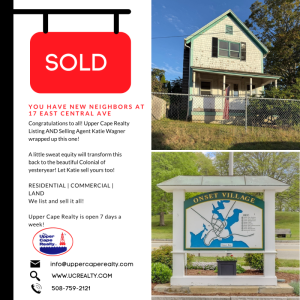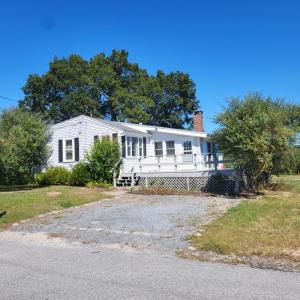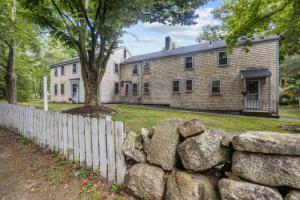New video tour features one of Dartmouth's oldest houses
 The exterior showing the 1801 addition as of 2015. COURTESY DARTMOUTH COMMUNITY TELEVISION
The exterior showing the 1801 addition as of 2015. COURTESY DARTMOUTH COMMUNITY TELEVISION A drawing of the Cummings house and surroundings from the 1830s. COURTESY DARTMOUTH COMMUNITY TELEVISION
A drawing of the Cummings house and surroundings from the 1830s. COURTESY DARTMOUTH COMMUNITY TELEVISION Bob Harding discusses the house's fireplaces. COURTESY DARTMOUTH COMMUNITY TELEVISION
Bob Harding discusses the house's fireplaces. COURTESY DARTMOUTH COMMUNITY TELEVISION Many of the windows in the 1801 addition are the hand-blown panes installed that year. COURTESY DARTMOUTH COMMUNITY TELEVISION
Many of the windows in the 1801 addition are the hand-blown panes installed that year. COURTESY DARTMOUTH COMMUNITY TELEVISION Wooden support structures are exposed in the kitchen. COURTESY DARTMOUTH COMMUNITY TELEVISION
Wooden support structures are exposed in the kitchen. COURTESY DARTMOUTH COMMUNITY TELEVISION The exterior showing the 1801 addition as of 2015. COURTESY DARTMOUTH COMMUNITY TELEVISION
The exterior showing the 1801 addition as of 2015. COURTESY DARTMOUTH COMMUNITY TELEVISION A drawing of the Cummings house and surroundings from the 1830s. COURTESY DARTMOUTH COMMUNITY TELEVISION
A drawing of the Cummings house and surroundings from the 1830s. COURTESY DARTMOUTH COMMUNITY TELEVISION Bob Harding discusses the house's fireplaces. COURTESY DARTMOUTH COMMUNITY TELEVISION
Bob Harding discusses the house's fireplaces. COURTESY DARTMOUTH COMMUNITY TELEVISION Many of the windows in the 1801 addition are the hand-blown panes installed that year. COURTESY DARTMOUTH COMMUNITY TELEVISION
Many of the windows in the 1801 addition are the hand-blown panes installed that year. COURTESY DARTMOUTH COMMUNITY TELEVISION Wooden support structures are exposed in the kitchen. COURTESY DARTMOUTH COMMUNITY TELEVISION
Wooden support structures are exposed in the kitchen. COURTESY DARTMOUTH COMMUNITY TELEVISIONAfter nearly three years in production, a Dartmouth Historical and Arts Society video history series of one of Dartmouth’s oldest houses is now airing on local television.
To celebrate, the historical society’s January 21 meeting doubled as a grand unveiling of the half-hour video tour of the 1702 Cummings house, located on Old Westport Road. Produced by Dartmouth Community Television and the society, it includes a tour of the house and historical photos from years past.
The home was built in 1702 by Phillip Cummings. The date is believed to be correct, but newer than initially thought. Originally, DHAS President Bob Harding explained the house was believed to date back to the mid-17th century. A recent discovery in a Dartmouth highway record from 1702, however, identified a new road being laid out near the “new” home.
Cummings worked as a constable, charged with collecting taxes from the early residents of Dartmouth. Cummings, however, refused to collect one particular tax, levied to fund a local congregational minister, due to his own religious beliefs. He was jailed by the county sheriff for refusing to collect the tax, where he later died.
Before his death, he willed his home and land to his family. His son John took possession of the home, and stayed in it for a time before selling it to Nicholas Howland, a member of the influential Dartmouth family. Members of other well-known Dartmouth families, like the Potters, also occupied the home.
In 1801, its new owner Peleg White added a front-facing, 50-foot addition to the original house in one of its largest renovations to date. The addition hides much of the older portion from street level when looking at the home from Old Westport Road.
Its 20th century owners brought the house up to date with then-modern amenities. In 1944, Americo Peitavino replaced an external outhouse surrounded by lilacs with indoor plumbing. The renovation also brought running water to the house.
In the 1970s, James Ragsdale purchased the home, and conducted extensive renovations and rehabilitation. He leveled sagging floors, made other repairs, and conducted research into its past owners.
“Much of what I’m telling you came from the research [the Ragsdales] did,” Harding said in the video.
The video tour included commentary from Eleanor Perry, who lived in the home in the 1940s and frequently visited it for several decades after that. She was able to provide insight on quirks and give historical background on the building’s past uses.
One such question was a strange star symbol discovered on several exterior doors, many of which are original to the house.
“It created a draft,” Perry explained in the video. “When the men were smoking it was used to hold the door open.”
Even with everything known about the house, there are still mysteries that need piecing together. It is possible, but not known for certain, that the house was part of the Underground Railroad. A rope ladder was once hidden behind a set of panels and connected the attic to the basement, and Eleanor attested to the existence of a lengthy tunnel below the house leading towards the Paskamansett River.
There is also debate as to whether the home once greeted long-distance travelers as a stagecoach stop. When the Ragsdales purchased the home in the 1970s, they discovered numbered plaques on second-floor bedroom doors, lending credence to the idea.T
he video history tour is airing now on DCTV. To watch the video online or for a schedule of future airings, visit town.dartmouth.ma.us/community-television-dctv.






































